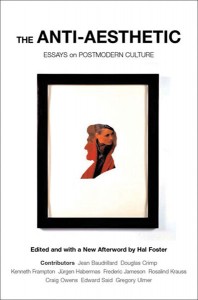 |
The Anti-Aesthetic: Essays on Postmodern Culture. Edited by Hal Foster. Port Townsend, Washington: Bay Press, 1983.
This slim volume, with essays by Habermas, Owens, Jameson, Baudrillard, et al., was a ubiquitous presence when I was a graduate student in the art criticism program at Stony Brook University in the late 1980s. Kenneth Frampton’s, “Towards a Critical Regionalism: Six Points for an Architecture of Resistance” was essential to my understanding of postmodern architecture and urban planning, and the rigor of Rosalind Krauss’ argument in “Sculpture in the Expanded Field” presented an enviable model for a beginning writer. I still think Foster’s introduction provides one of the most succinct definitions of postmodernism ever written. Always one to judge a book by its cover, I loved the Richard Prince photo set on a lavender ground and marveled that this important compilation was published in Port Townsend, a harbor I knew well from my childhood sailing in the San Juan Islands.
|